How long are Cats Pregnant? Stages, Facts and Care Full Guide
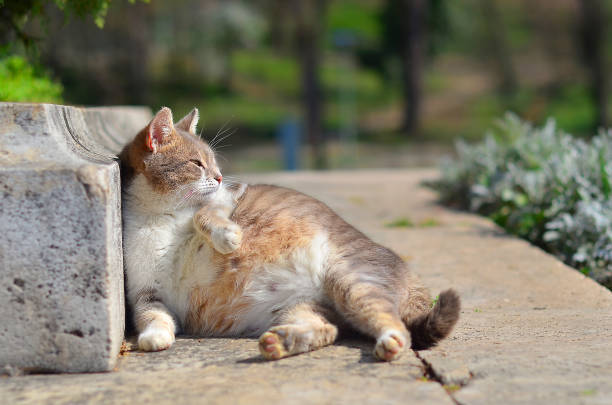
How long are Cats Pregnant?, “Cats’ pregnancy, also known as gestation, typically lasts around 63 to 65 days. Understanding the duration of a cat’s pregnancy is crucial for pet owners and breeders alike. Knowing this timeline enables proper care and preparation for the mother cat and her litter. During this period, it’s essential to provide the pregnant cat with a balanced diet, regular vet check-ups, and a comfortable, stress-free environment to ensure the health and well-being of both the mother and her kittens.”
“Inquiring about How long are Cats Pregnant is common among cat owners and those interested in breeding. With a gestation period of about two months, cats undergo significant physical and hormonal changes to support the growth and development of their offspring. This knowledge empowers owners to anticipate the arrival of new additions to their feline family and to be vigilant for any signs of complications during pregnancy or labor. Overall, understanding the duration of a cat’s pregnancy is essential for responsible cat care and breeding practices.”
How long are Cats Pregnant
Cats are pregnant around about 63 to 65 Days and last up to 72 Days. During pregnancy, a cat’s nutritional needs may change, requiring a diet rich in essential nutrients to support the development of her offspring. Regular veterinary check-ups are also important to monitor the progress of the pregnancy and address any potential health concerns. Additionally, creating a comfortable and stress-free environment for the expectant mother cat is essential for her well-being and the successful delivery of her litter.
How will my Feline Expert know if my Cat is Pregnant?
When you suspect that your cat might be pregnant, your veterinarian can confirm it through several methods.
Physical Examination
Your vet will begin by conducting a thorough physical examination of your cat. They will palpate your cat’s abdomen gently to feel for any signs of pregnancy, such as the presence of developing fetuses or changes in the size and shape of the uterus.
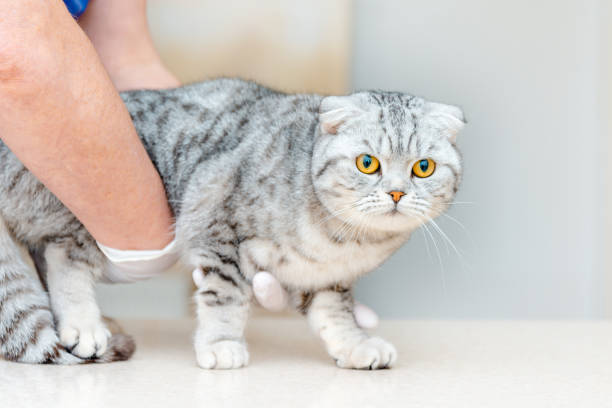
Ultrasound
An ultrasound scan is a reliable method for confirming pregnancy in cats. This non-invasive procedure allows the vet to visualize the growing fetuses within the cat’s uterus. Ultrasound can also help determine the number of kittens and evaluate their development.
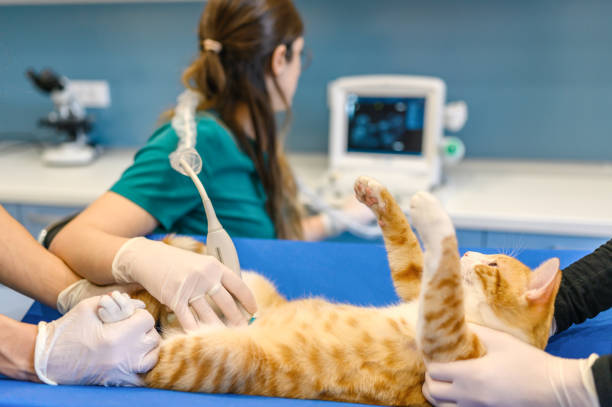
Hormone Testing
Hormone testing can also be used to confirm pregnancy in cats. Your vet may take a blood sample to measure hormone levels, such as progesterone, which typically increase during pregnancy. However, this method may not be as accurate as ultrasound or palpation.
X-rays (Radiography)
X-rays are another diagnostic tool that can be used to confirm pregnancy in cats, particularly during the later stages. X rays can reveal the presence of fetal skeletons, making them useful for estimating the number of kittens and assessing their size and position.
Observation of Behavioral and Physical Changes
Your vet may also consider your cat’s behavioral and physical changes as indicators of pregnancy. These changes may include an increase in appetite, weight gain, nipple enlargement, and nesting behaviors. While these signs can suggest pregnancy, they are not conclusive on their own.
By using a combination of these methods, your veterinarian can accurately determine whether your cat is pregnant and provide you with the necessary guidance and care instructions for the duration of her pregnancy. Regular veterinary check-ups throughout the gestation period will ensure the health and well-being of both the expectant mother cat and her future kittens.

How do I care for my pregnant cat?
Confirm Pregnancy
Schedule a veterinary appointment to confirm your cat’s pregnancy through physical examination, ultrasound, or other diagnostic methods.
Provide Proper Nutrition
Transition your pregnant cat to a high-quality, balanced diet specifically formulated for pregnant and nursing cats. Offer her regular meals to ensure she receives adequate nutrition for herself and her developing kittens.
Ensure Regular Veterinary Check-Ups
Schedule regular check-ups with your veterinarian throughout your cat’s pregnancy. Your vet will monitor her health, provide guidance on prenatal care, and address any concerns or complications that may arise.
Create a Comfortable Environment
Provide a quiet, safe, and comfortable space for your pregnant cat to rest and nest. Offer her a cozy bed in a secluded area away from household traffic and noise.

Monitor Weight Gain
Monitor your cat’s weight gain throughout her pregnancy. A gradual increase in weight is normal, but sudden or excessive weight gain may indicate health issues such as obesity or complications with the pregnancy.
Observe Behavioral Changes
Pay attention to any behavioral changes in your pregnant cat, such as increased nesting behavior or decreased activity levels. These changes are normal as your cat prepares for birth, but contact your veterinarian if you notice any concerning symptoms.
Prepare for Labor
As your cat’s due date approaches, prepare a birthing box or nesting area where she can give birth comfortably. Include soft bedding, towels, and a heat source to keep the kittens warm.
Monitor Labor
During labor, monitor your cat from a distance to ensure she is progressing normally. Contact your veterinarian if you notice prolonged labor, signs of distress, or if more than two hours pass between kitten births.
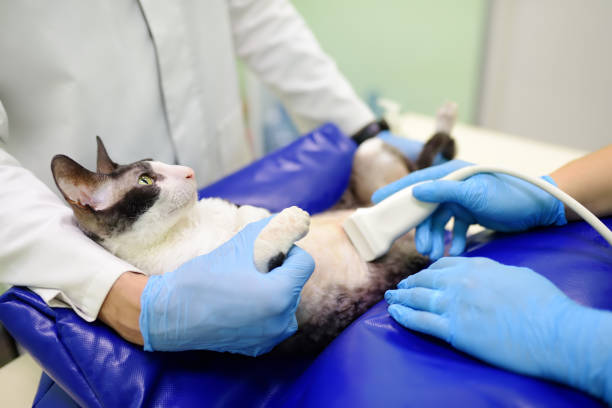
Provide Postnatal Care
After birth, provide your cat with a quiet and warm environment to bond with her kittens. Ensure she has access to fresh water and continue feeding her a nutritious diet to support nursing.
Schedule Postpartum Check-Up
Schedule a postpartum check-up for your cat and her kittens to ensure they are healthy and thriving. Your veterinarian will examine them, provide vaccinations if needed, and offer guidance on kitten care and weaning.
By following this step-by-step guide and providing attentive care throughout your cat’s pregnancy and postpartum period, you can help ensure the health and well-being of your cat and her kittens.
Pregnancy in Cats: All Stages with Full Details
Stage 1: Preparing for Pregnancy
① Ensure your cat is healthy and up-to-date on vaccinations before breeding.
② Consider consulting with a veterinarian or feline expert to assess your cat’s suitability for breeding.
③ Choose a suitable mate with desirable traits and compatible health status.
④ Plan the timing of mating carefully to maximize the chances of conception.
Stage 2: Mating and Fertilization
① Female cats (queens) typically go into heat (estrus) every 2-3 weeks, signaling their readiness to mate.
② Allow your queen and the chosen male (tom) to mate naturally or facilitate mating under supervision.
③ During mating, the tom will bite the queen’s neck and mount her briefly, after which fertilization occurs.
④ Once mating is successful, the queen’s reproductive system begins the process of fertilizing the eggs.
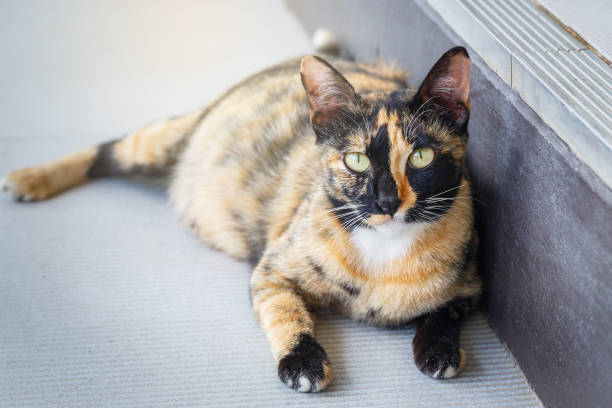
Stage 3: Early Pregnancy (First 3 Weeks)
① After successful mating, fertilized eggs travel to the uterus for implantation.
② During this period, there may not be noticeable physical changes in the queen.
③ It’s crucial to continue providing proper nutrition and care to support early embryonic development.
④ Queens may show subtle behavioral changes such as increased affection or appetite.
Stage 4: Mid-Pregnancy (Weeks 4-6)
① By week 4, embryos develop into recognizable fetuses with distinct features.
② The queen’s abdomen may start to show slight enlargement as the kittens grow.
③ Hormonal changes may cause fluctuations in appetite and behavior.
④ Schedule a veterinary visit for a check-up and confirmation of pregnancy if not already done.

Stage 5: Late Pregnancy (Weeks 7-9)
① During the final weeks of pregnancy, the queen’s abdomen noticeably enlarges as the kittens continue to grow.
② Nesting behavior becomes more apparent as the queen prepares for birth.
③ Provide a quiet, warm, and comfortable birthing area for the queen to give birth.
④ Monitor the queen closely for signs of labor, such as restlessness, panting, and nesting behavior.
Stage 6: Labor and Delivery
① Labor typically begins with the queen experiencing contractions as she prepares to deliver her kittens.
② Kittens are born in individual amniotic sacs, which the queen may rupture and remove.
③ The queen may alternate between resting and actively delivering kittens until all are born.
④ Provide gentle support and assistance if needed, but allow the queen to handle the birthing process naturally.

Stage 7: Postpartum Care
① After all kittens are born, the queen will clean them, stimulate their breathing, and encourage them to nurse.
② Ensure the queen and kittens have a quiet, warm, and safe environment for bonding and nursing.
③ Monitor the queen for signs of postpartum complications such as retained placenta or mastitis.
④ Continue providing nutritious food and fresh water for the queen to support her recovery and milk production.
Stage 8: Kitten Development and Weaning
① Kittens grow rapidly during the first few weeks, relying entirely on their mother’s milk for nourishment.
② Gradually introduce solid food to the kittens starting around 3-4 weeks of age.
③ Monitor the kittens’ growth and development, and schedule veterinary visits for vaccinations and health checks.
④ Wean the kittens gradually over several weeks, allowing them to transition to solid food and independence.
By understanding and attending to each stage of pregnancy in cats with care and attention, you can help ensure the health and well-being of both the queen and her kittens. Regular veterinary check-ups and proper nutrition are essential throughout the entire process.
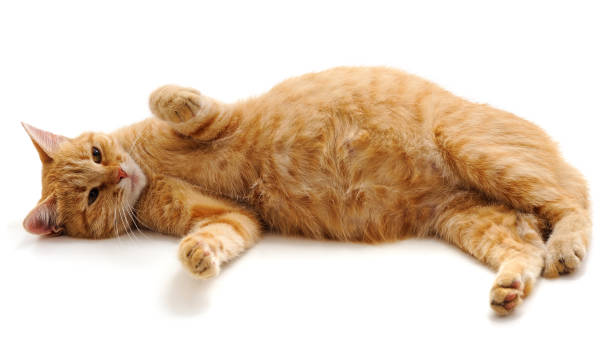
Frequently Asked Questions
How long are cats pregnant?
Cats are typically pregnant for around 63 to 65 days. However, this timeframe can vary slightly depending on factors such as the individual cat’s breed, health, and environmental conditions. Ans of this Questions, How long are Cats Pregnant
Are there any signs that my cat is pregnant?
Yes, there are several signs that may indicate your cat is pregnant. These include changes in appetite, weight gain, nipple enlargement, and nesting behaviors. However, the most reliable way to confirm pregnancy is through a veterinary examination.
Can cats have false pregnancies?
Yes, cats can experience false pregnancies, also known as pseudopregnancy. During a false pregnancy, a cat may exhibit symptoms similar to those of a real pregnancy, including nesting behavior and abdominal enlargement. However, there are no developing kittens present, and the symptoms typically resolve on their own.
When should I take my pregnant cat to the vet?
It’s essential to take your pregnant cat to the vet as soon as possible after confirming her pregnancy. Your vet can provide guidance on prenatal care, monitor the pregnancy’s progress, and address any potential health concerns to ensure a safe and healthy delivery.
How can I prepare for my cat’s labor and delivery?
To prepare for your cat’s labor and delivery, create a quiet, warm, and comfortable birthing area for her. Include soft bedding, towels, and a heat source to keep the kittens warm. Monitor your cat closely for signs of labor, such as restlessness and panting, and be prepared to provide gentle support if needed.
Share this content:
